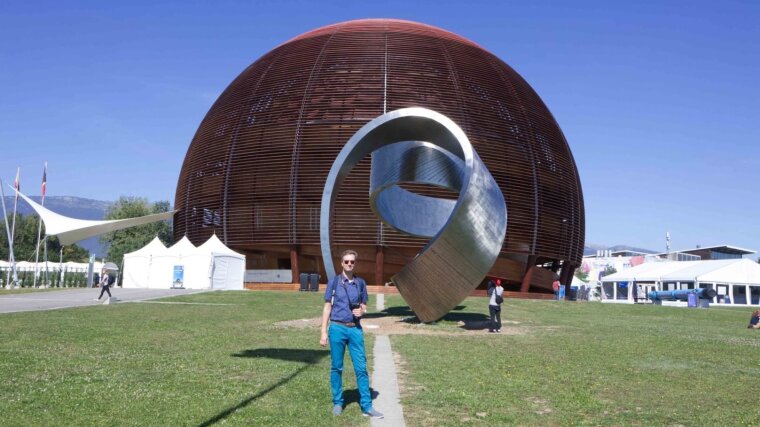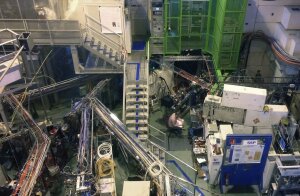
Astatine is a halogen and one of the rarest elements in the world – there are less than 50 grams of it in the earth’s crust. It is produced when radioactive heavy metals (e.g. uranium) decay and only exists for a few minutes before decaying itself. Due to this volatility, it takes a great deal of technical effort for physicists like Oliver Forstner to artificially produce and study the ›unstable‹ element, as it is translated from the Greek. The large-scale equipment required for such purposes is available at the CERN research centre. But how do researchers even work with such a scientific machine?
By Sebastian Hollstein
»First of all, it’s very important that you aren’t overawed by such facilities if you want answers to your questions,« says Oliver Forstner. And nobody knows this better than the physicist from the University of Jena, who spent three years conducting research at CERN during his doctoral thesis. He returned for a few experiments in 2019, joining an international team of scientists who wanted to learn more about astatine. The European Organization for Nuclear Research (CERN) near Geneva is home to the Isotope Mass Separator On-Line Device (ISOLDE), which can be used to produce various isotopes. For example, if a proton beam produced by a particle accelerator is directed onto the element bismuth, its atomic nuclei are split up. This creates astatine isotopes that can be passed on for further experiments.
However, such a project requires a lot of preparation. The scientists first have to apply for beamtime for the large-scale equipment. »You have to explain the preliminary work that has been done and outline the current state of research,« says Forstner. »You should also have detailed plans for the experiment you want to conduct with the equipment, because you have to indicate a specific number of eight-hour shifts for the equipment«. The researchers have to estimate as precisely as possible how long they will need to set up and carry out their experiments and how many runs they will need to obtain a meaningful result. The selection process also includes an oral presentation before the committee, which ultimately assigns appointments based on the scientific relevance of the proposed project. This application phase took approximately six months for the astatine project.
An experimental set-up in the ISOLDE hall. The researcher stands in front of the experimental set-up where laser beams are shot at astatine ions. The lasers are located in the grey room on the first floor of the stairway. The researcher is using an oscilloscope to monitor the signals of neutral astatine atoms coming from a detector and is making notes in an analogue logbook.
Image: Oliver Forstner/Uni JenaPlaces of experimentation and exchange
Once the schedule has been approved, the next stages of the preparation work are more practical. As part of the extensive registration process, for example, those who are going to use the equipment must submit medical documents to prove they are fit enough to work under such strain. They also have to complete radiation protection courses beforehand. »After putting in this effort, you can put all your focus on your scientific experiments on site,« says Forstner. »There is usually an atmosphere of full concentration at the facilities, because everyone obviously wants to obtain new and valuable data that will further their research and not waste precious beamtime«.
Centres like CERN are not just places of experimentation, but also places for sharing thoughts and experiences. »An international group like ours doesn’t get the chance to meet up that often, so our experiments are a good opportunity for this and lay the foundations for the next steps to be discussed,« explains Forstner. »The facilities and institutions connected to such large-scale equipment usually provide the ideal infrastructure for such meetings. You can really feel the international atmosphere at CERN«. The Swiss research centre also offers a good networking environment – not so much during working hours but certainly in the canteens and restaurants on campus, where scientists can make new contacts and sometimes find valuable impetus for their current and future projects. They often sit together late at night and discuss their experiments or even chat about football and other things.
Forstner’s team needed around ten days of beamtime. His teammates worked around the clock in several shifts and it all came together. »We first set up our experiment on the particle accelerator itself,« explains the physicist. »This installation is checked again by a safety engineer. When the equipment starts operating, you mainly stay in the monitoring room to control certain values that tell you whether the experiment is generally working«. The researchers then process this data, which fills up a few hard drives, to come up with scientific findings at their own desks. Oliver Forstner is even benefiting from his past experiments during his current work. And his next date with ISOLDE has already been made.
Astatine’s electron affinity
Forstner and his team observed as negative astatine ions, which had been produced previously, were exposed to laser light of different wavelengths in the specially developed machine. The researchers were able to measure the amount of energy needed to separate the additional electron from the ion and turn it into a neutral atom. This experiment enabled the scientists to precisely determine astatine’s electron affinity and electronegativity. This information can be combined with its ionization potential to ultimately determine the halogen’s chemical properties. This will not only help to advance basic research; it could also pave the way for astatine to be used in the fight against cancer. In conjunction with organic proteins, medical professionals could direct it to specific tumours, which would then be destroyed by the element’s alpha decay. This way, the ›unstable‹ element could even save lives (DOI: 10.1038/s41467-020-17599-2External link).
